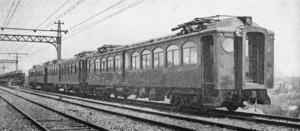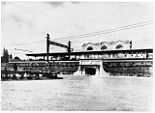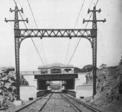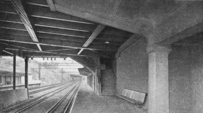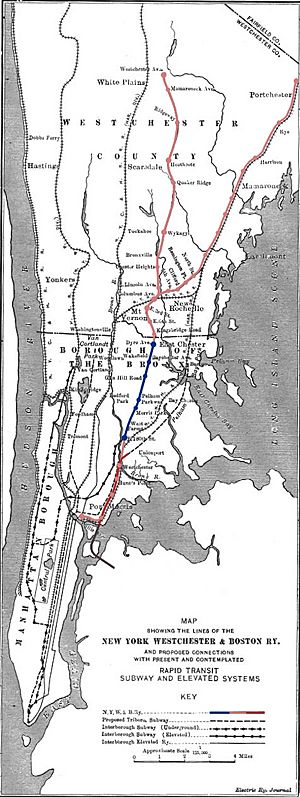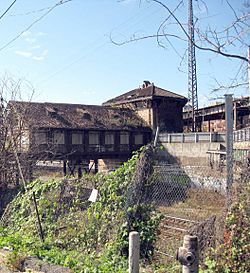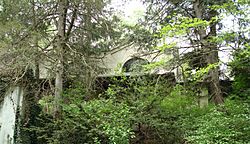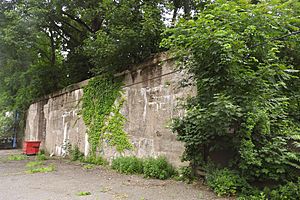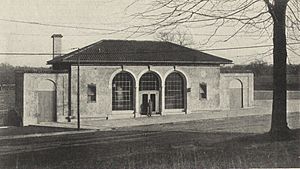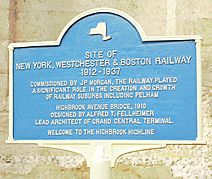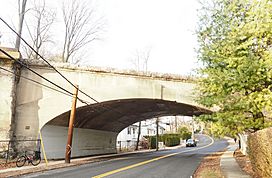New York, Westchester and Boston Railway facts for kids
 |
|
| Overview | |
|---|---|
| Headquarters | Bronx, New York |
| Reporting mark | NYWB |
| Locale | New York |
| Dates of operation | 1912–1937 |
| Successor | New York City Transit Authority (IRT Dyre Avenue Line) |
| Technical | |
| Track gauge | 4 ft 8 1⁄2 in (1,435 mm) standard gauge |
The New York, Westchester and Boston Railway Company (NYW&B) was an electric train system. People often called it "the Westchester" or "Boston-Westchester." It operated in the Bronx and Westchester County, New York from 1912 to 1937.
The railway started in the southern South Bronx, near the Harlem River. It ran north to Mount Vernon. From there, it had branches going to White Plains and Port Chester. The New York, New Haven and Hartford Railroad (NH) controlled its building and operation from 1906. This continued until the NH went bankrupt in 1935.
About 4 miles (6 km) of the original line are still used today. This section is part of the New York City Subway's IRT Dyre Avenue Line (the 5 train).
Contents
The Story of the Westchester Railway
Early Ideas and Beginnings
In 1871, a company called the Southern Westchester Railroad was formed. It planned to build a railway from the Harlem River to White Plains. This was similar to the path the NYW&B later took. But by 1875, this company ran into money problems and closed down in 1881.
Another company, also called the New York, Westchester and Boston Railway Company (NYW&B), started in 1872. It aimed to serve areas north of New York City. Its plans included lines from the Harlem River to Throgs Neck in the Bronx. It also planned lines to Port Chester and White Plains in Westchester County. However, a financial crisis in 1873 stopped it from getting money to build. The company faced financial difficulties until 1904.
Starting in 1874, parts of Westchester County became part of New York City. This process finished by 1898, creating the Bronx as we know it. This meant much of the NYW&B's planned route was now under New York City's control.
In 1901, another company, the Harlem River & Port Chester Railroad (HR&PC), was created. It planned a route similar to the NYW&B's. Then, in 1904, the NYW&B got back on its feet. It started buying land for its railway. In 1906, bankers bought the NYW&B's shares. After another financial crisis in 1907, the NYW&B became part of the New York, New Haven and Hartford Railroad (NH). The NH was trying to control all rail and water transport in southern New England.
A disagreement between the HR&PC and NYW&B was settled. The NYW&B bought the HR&PC's rights in 1909. By 1910, the NH fully controlled the NYW&B. This included business deals made when the famous banker J. P. Morgan was involved.
Building the Railway
Construction of the NYW&B began in 1909. The railway was built to a very high standard. It ran from 180th Street to White Plains and through Pelham. Building the railway and buying the trains cost over $1.2 million per mile. This was a huge amount of money in 1910!
The tracks were strong and heavy. The railway had gentle slopes and curves. This made for a smooth ride.
The stations were beautiful. They were made of concrete with marble inside. They had high platforms, which helped passengers get on and off trains quickly. The railway was built so that no public roads crossed the tracks at ground level. This meant building many expensive bridges, tunnels, and raised tracks. From 180th Street to Columbus Avenue, the line had four tracks. Then it had two tracks to White Plains and Port Chester.
The extension from New Rochelle to Port Chester was built more simply. It had wooden platforms and simpler stations. This part of the line was finished in stages: Larchmont in 1921, Mamaroneck in 1926, Harrison in 1927, Rye in 1928, and Port Chester in December 1929. A new station was added in White Plains in 1929 to serve a growing area.
How the Railway Operated
Passenger service started on May 29, 1912. It ran between Adams Street in the Bronx (now the East 180th Street station) and North Avenue in New Rochelle. People thought commuters would choose a cheaper, more comfortable ride into the Bronx. From there, they could transfer to the elevated IRT Third Avenue Line to get to Manhattan. On July 1, 1912, a branch opened to Westchester Avenue in White Plains. On August 3, trains started running all the way to the New York, New Haven and Hartford Railroad's Harlem River Branch. This connected to the Third Avenue Line.
The NYW&B had modern electric trains and very smooth tracks. However, not enough people wanted to ride the NYW&B and then transfer to another train. They preferred the direct service to Grand Central Terminal, even if it cost more.
The railway had to run trains at least twice an hour. During busy times, it ran trains up to six times an hour. Trains had one to six cars. The number of passengers grew from 2.9 million in 1913 to 14.1 million in 1928. When the Port Chester branch was completed in 1929, the New Haven company stopped its passenger service on its Harlem River branch. The NYW&B did not carry much freight.
The NYW&B saved money by not using Grand Central Terminal. But it charged lower fares, which meant it didn't make enough money. It never earned enough to pay the interest on its loans, which the NH had guaranteed.
Facing Competition
After J. P. Morgan died in 1913, competition between the NH and the New York Central Railroad (NYC) grew stronger. The NYW&B's White Plains line ran about two miles (3 km) east of the NYC's Harlem Line. The Harlem Line served towns along the Bronx River. Its trains went directly into Manhattan, which was a big advantage.
The Port Chester line ran next to NH tracks for more than half its length. It was also only two miles west of NH's Harlem River Branch. Even though NH's Harlem Branch trains ended at the Harlem River terminal, regular NH commuter trains went to Grand Central.
When the NH went bankrupt, the NYW&B's ownership separated from the NH. The NH's trustee could then end the NYW&B's lease for its tracks from New Rochelle to Port Chester. This meant the NYW&B lost income. The connections at Harlem River and East 180th Street were not as convenient as direct service to Grand Central. The big growth of suburbs after World War II came too late to help the NYW&B.
The End of the Line
The NH had been covering the NYW&B's debts. So, when the NH went bankrupt in 1935, the NYW&B did too. A trustee was appointed to try and save the Westchester railway. But the trustees for the NH and NYW&B bankruptcies had different goals. This caused problems.
The NYW&B was forced to stop running trains on the Port Chester line. This was done to help the NH earn more money from its own parallel service. The NYW&B lost revenue and couldn't cut costs enough. If the NYW&B had stayed open, the New Haven would have had to pay off a bond issue due in 1946. So, closing the NYW&B completely was the only option. The NYW&B stopped operating on December 31, 1937.
There were attempts to bring the service back. A bill to create a new "Bronx-Westchester Railroad Authority" almost passed. It would have bought and run the Westchester for public use. But the New York City Mayor stopped it. The only successful effort was when New York City bought the tracks and stations between 180th Street and Dyre Avenue. After adding a third rail, it became a shuttle service. Later, with new connecting tracks, it became the IRT Dyre Avenue Line we know today.
During World War II, the railway's steel, bridges, and electrical system were taken apart. The metal was used for the war effort in 1942. Other assets, mainly land, were sold by 1946. This marked the final end of the company.
Some of the original train cars were sent to Texas during World War II. They were used to carry workers from Houston to shipyards in Pasadena to build ships. This train was called the "shuttle train" and ran until the war ended.
Equipment and Power
The NYW&B trains got their power from overhead lines. These lines carried 11,000 volts of electricity. This was the same system used by the New Haven railway. The New Haven's power plant generated the electricity, and the NYW&B received it in New Rochelle.
The main trains used by the NYW&B were 95 electric coaches. These trains had doors in the middle for high platforms and doors at the ends for low platforms. They could go up to 57 miles per hour. The 11,000-volt power from the overhead lines was reduced to 250 volts to run the train motors. The NYW&B also had one powerful 655-horsepower locomotive for moving freight and for other work.
Stations and Route
The NYW&B route started at Harlem River station at 132nd Street. A walkway connected it to other elevated train lines. The NYW&B tracks ran next to the NH's tracks, sharing four stations. Just south of 180th Street was the company's headquarters, repair shops, and a major transfer point to the New York City Subway. From 180th Street, the railway had its own four tracks. It served six stations in the Bronx and three in Mount Vernon. The routes then split at Columbus Avenue.
One line went north. It had one more station in Mount Vernon. Then it went through Chester Heights in Eastchester, Wykagyl and Quaker Ridge in northern New Rochelle. It also stopped at Heathcote, on the border of New Rochelle and Scarsdale. Finally, it reached Ridgeway, Gedney Way, and Mamaroneck Avenue stations in White Plains. The White Plains terminal was on the eastern edge of downtown.
The other line went east. It had the Fifth Avenue station in North Pelham, the Pelhamwood station on the New Rochelle/Pelham border. Then it had the Remington, North Avenue, and Pine Brook stations in central New Rochelle. This route ran on its own tracks next to the NH line from New Rochelle. It served the same stations as the NH between New Rochelle and Port Chester. It also had the Larchmont Gardens station in Larchmont and the West Street station in Harrison.
List of Stations
| Milepost | City | Station | Tracks | Platform | Date opened | Date closed | Connections and notes |
|---|---|---|---|---|---|---|---|
| 0.0 | Bronx | Harlem River | 5 | 5 High | August 3, 1912 | December 31, 1937 | NYNH&H Harlem River Branch (until 1930) New York City IRT Third Avenue elevated |
| 0.91 | Bronx | Port Morris | 2 | 2 Low | August 3, 1912 | December 31, 1937 | NYNH&H Harlem Branch (until 1930) |
| 1.90 | Bronx | Casanova | 2 | 2 Low | August 3, 1912 | December 31, 1937 | NYNH&H Harlem Branch (until 1930) |
| 2.57 | Bronx | Hunt's Point | 2 | 2 Low | August 3, 1912 | December 31, 1937 | NYNH&H Harlem Branch (until 1930) |
| 3.19 | Bronx | Westchester Avenue | 2 | 2 Low | August 3, 1912 | December 31, 1937 | NYNH&H Harlem Branch (until 1930) |
| 4.37 | Bronx | East 180th Street | 4 | 4 High | May 29, 1912 | December 31, 1937 | New York City Subway IRT White Plains Road Line |
| 5.50 | Bronx | Morris Park | 4 | 2 High | May 29, 1912 | December 31, 1937 | |
| 5.90 | Bronx | Pelham Parkway | 4 | 4 High | May 29, 1912 | December 31, 1937 | |
| 6.74 | Bronx | Gun Hill Road | 4 | 2 High | May 29, 1912 | December 31, 1937 | |
| 7.56 | Bronx | Baychester Avenue | 4 | 2 High | May 29, 1912 | December 31, 1937 | |
| 8.33 | Bronx | Dyre Avenue | 4 | 2 High | May 29, 1912 | December 31, 1937 | |
| 8.63 | Mount Vernon | Kingsbridge Road | 4 | 2 High | May 29, 1912 | December 31, 1937 | |
| 9.24 | Mount Vernon | East Sixth Street | 4 | 2 High | May 29, 1912 | December 31, 1937 | |
| 9.79 | Mount Vernon | East Third Street | 4 | 4 High | May 29, 1912 | December 31, 1937 | |
| 10.27 | Mount Vernon | Columbus Avenue | 4 | 2 High | May 29, 1912 | December 31, 1937 | NYNH&H at Columbus Avenue |
| Services to Westchester Avenue and Port Chester split | |||||||
| Service to Westchester Avenue | |||||||
| 10.66 | Mount Vernon | East Lincoln Avenue | 2 | 2 High | July 1, 1912 | December 31, 1937 | East Lincoln Avenue between Station Place and Hutchison Boulevard |
| 11.63 | Eastchester | Chester Heights | 2 | 2 High | July 1, 1912 | December 31, 1937 | |
| 13.01 | New Rochelle | Wykagyl | 4 | 4 High | July 1, 1912 | December 31, 1937 | |
| 15.09 | New Rochelle | Quaker Ridge | 2 | 2 High | July 1, 1912 | December 31, 1937 | |
| 15.95 | New Rochelle/Scarsdale | Heathcote | 4 | 4 High | July 1, 1912 | December 31, 1937 | |
| 17.51 | White Plains | Ridgeway | 2 | 2 High | 1929 | December 31, 1937 | |
| 18.26 | White Plains | Gedney Way | 2 | 2 High | 1913–1914 | December 31, 1937 | |
| 18.89 | White Plains | Mamaroneck Avenue | 2 | 2 High | July 1, 1912 | December 31, 1937 | |
| 19.50 | White Plains | Westchester Avenue | 4 | 4 High | July 1, 1912 | December 31, 1937 | Connecting local trolley service |
| Service to Port Chester | |||||||
| 10.95 | Pelham | Fifth Avenue | 2 | 2 High | May 29, 1912 | December 31, 1937 | Fifth Avenue and Third Street |
| 11.27 | Pelham / New Rochelle | Pelhamwood | 2 | 2 High | May 29, 1912 | December 31, 1937 | Was named "Clifford" until 1916 |
| 11.67 | New Rochelle | Remington Place (Webster Avenue) |
2 | 2 High | May 29, 1912 | December 31, 1937 | |
| 12.17 | New Rochelle | North Avenue | 2 | 2 High | March 20, 1921 | October 31, 1937 | |
| 13.02 | New Rochelle | Pine Brook | 2 | 2 High | March 20, 1921 | October 31, 1937 | |
| 14.03 | Larchmont | Larchmont (Chatsworth Avenue) | 2 | 2 High | March 20, 1921 | October 31, 1937 | NYNH&H at Larchmont |
| 14.78 | Mamaroneck | Larchmont Gardens | 2 | 2 High | 1926 | October 31, 1937 | |
| 15.83 | Mamaroneck | Mamaroneck | 2 | 2 High | March 21, 1926 | October 31, 1937 | NYNH&H at Mamaroneck |
| 16.82 | Harrison | West Street | 2 | 2 High | 1927 | October 31, 1937 | |
| 17.60 | Harrison | Harrison | 2 | 2 High | July 3, 1927 | October 31, 1937 | NYNH&H at Harrison |
| 19.44 | Rye | Rye | 2 | 2 High | July 1, 1928 | October 31, 1937 | NYNH&H at Rye |
| 20.90 | Port Chester | Port Chester | 2 | 2 High | December 7, 1929 | October 31, 1937 | NYNH&H at Port Chester |
Future Plans That Didn't Happen
In 1906, there were plans for a branch line to Elmsford. This line would have split from the White Plains branch. However, the village of Elmsford voted against the railway. They didn't like how it would look, so the plan was dropped.
Another company, the Westchester Northern Railroad (WN), was formed in 1910. It planned to extend the NYW&B north from White Plains. One branch would go to Danbury, Connecticut, and another to Brewster, New York. The NYW&B's White Plains station was even built with this extension in mind. The WN joined with the NYW&B in 1915. But most of the work was just buying land. No major construction happened. The WN project was officially canceled by 1925.
There was also a proposal to extend the NYW&B from its Harlem River terminal. It would go underground through a new tunnel and connect to the Independent Subway System (IND) in Manhattan. But this idea never happened.
The NYW&B crossed the New Haven railway at a shared station in Mount Vernon. A ramp was designed to allow NYW&B trains to go directly to Grand Central. But no tracks were ever built for this connection. The New Haven company likely didn't want more trains going into Grand Central. They had to pay a fee to the NYC for every train that used the terminal.
What's Left Today?
In the Bronx
The part of the railway in the Bronx north of the East 180th Street station is still used. It is now the IRT Dyre Avenue Line. This line carries 5 trains from East 180th Street to Eastchester-Dyre Avenue.
The old New York, Westchester and Boston Railroad Administration Building at 180th Street now holds offices for the New York City Transit Authority.
Some parts of the old railway path are still visible. For example, between East 141st Street and East 133rd Street in Port Morris, the old roadbed is well preserved. One track and some bridges and power structures remain.
An abandoned station entrance can be seen near the Whitlock Avenue station. This was the old Westchester Avenue station.
In Larchmont and Mamaroneck
The old Larchmont Gardens station building is now used by a Girl Scouts facility.
You can see concrete supports for old bridges throughout Mamaroneck. For example, at Jefferson Street, Mamaroneck Avenue, and Fenimore Road. The extended power structures where the NH and NYW&B shared tracks still exist in many places.
The tunnel leading to the NYW&B platforms behind the Mamaroneck Metro-North station is still there. This station was shared by both the New Haven and NYW&B.
In Mount Vernon
Large concrete bridge supports remain at Hutchinson Boulevard in Mount Vernon. A street called Lorraine Terrace runs along the old rail line. Parts of the Columbus Avenue station are still in place.
The East Third Street Station building in Mount Vernon was being torn down around 2016 for new development.
Parts of the Kingsbridge Road station, north of the Bronx/Mount Vernon border, are still there. Most of the sealed station building and the elevated line remain.
In New Rochelle
The old Quaker Ridge Station is now a private home. The old driveway and turnaround are now public streets. The house still has its two main platforms.
A concrete wall runs along Stratton Road near the Quaker Ridge station. It matches the station's style and was likely built to block road noise.
Some traces of the railway are in Ward Acres Park. The Ward family, who owned the estate, used the railway. They built a short track to load and unload horses. A concrete building, called "The Forge," is on the old railway path in the park. There is also a small section of track still intact north of "The Forge."
A stone bridge in Ward Acres Park crosses a stream along the old railway path. It is in perfect condition.
The old Wykagyl station is now part of a shopping center. The building was badly damaged by a fire in 2012. The shopping area around Wykagyl is built on the old NYW&B railway property.
White Plains Branch Remnants
The Heathcote Bypass uses 1.13 miles (1.82 km) of the old NYW&B path. This bypass helps avoid a busy intersection called "The Five Corners."
New Rochelle Branch and Port Chester Extension Remnants
The old Remington Station building on Webster Avenue in New Rochelle is now used by stores.
The old railway path west of Remington Station to the Pelham border still exists. It is bordered by residential streets.
The southbound I-95 exit and entrance ramps at Cedar Street in New Rochelle were built on the old trackbed of the NYW&B's North Avenue station.
A concrete support wall from an old NYW&B overpass is still visible on Prince Street. One side of an overpass that carried a street over both the New Haven and NYW&B lines remains behind a Stop & Shop on Palmer Avenue. It is next to the old Pine Brook Station.
In Pelham
On Highbrook Avenue, there is a bridge that once carried the NYW&B tracks. A group called "The Highbrook Highline" is working to preserve this bridge.
In Scarsdale
The old Heathcote station is now a real estate office. The village of Scarsdale officially recognized the building's 100th anniversary in 2012.
The Heathcote Bypass uses part of the old NYW&B path.
In White Plains
Much of the old railway path in White Plains is now the White Plains Greenway. This is a walking trail. It runs east of Old Mamaroneck Road, south from the old Mamaroneck Avenue station to the city border with Scarsdale.



